These are common bonsai problems and solutions in Los Angeles, US, and you’re not alone. Basically, the Los Angeles climate, with its Mediterranean heat, dry air, and strong Santa Ana winds, makes it harder for both indoor bonsai trees and outdoor bonsai to stay happy.
Many local growers notice leaf scorch, root rot, or pest infestations on their California juniper bonsai, lavender star bonsai, or even jade bonsai.
Most of these issues come from overwatering, underwatering, or poor bonsai soil that doesn’t drain well. But there’s an easy fix to start by using a mix of akadama, pumice, and lava rock for better air flow. Water only when the topsoil feels dry, move your bonsai away from heat-reflective walls, and give it filtered sunlight during LA’s hot afternoons.
By adjusting your routine to match the Southern California climate and protecting your bonsai from dry winds and low humidity, your bonsai plant will recover quickly. It’s a lavender star flower bonsai, Ficus, or California juniper, a dwarf plant with common bonsai problems and solutions in Los Angeles, US. You can grow a strong, green tree that thrives all year in Los Angeles.
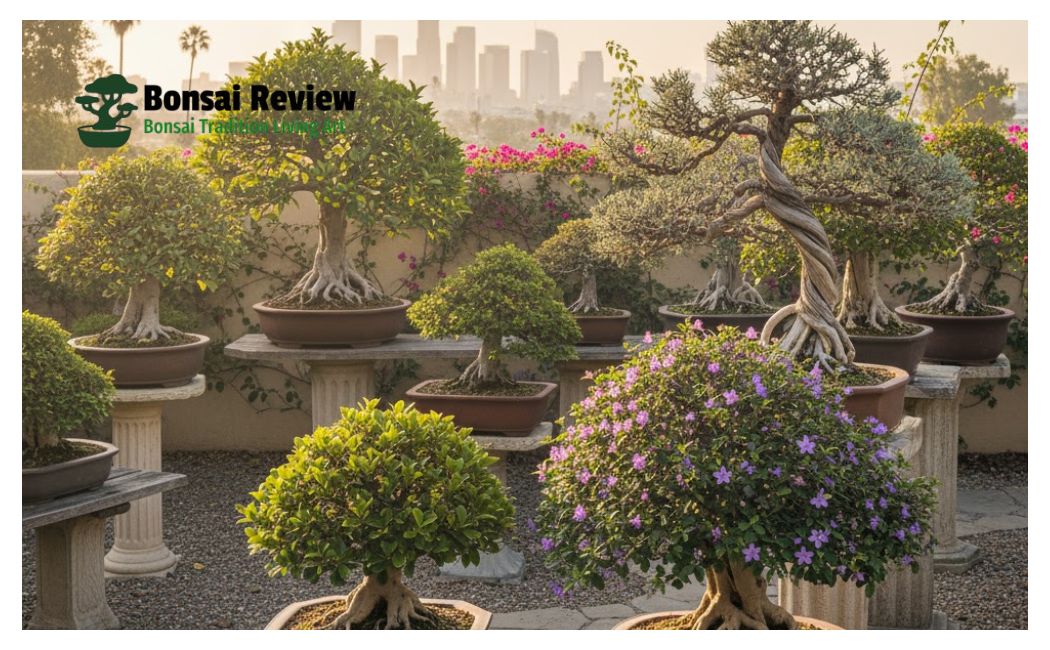
Why Bonsai Trees Struggle in the Los Angeles Climate?
You might care for your bonsai every day, yet still see yellow leaves, dry soil, or slow growth. That’s not your fault, common bonsai problems and solutions in Los Angeles, US climate. The city’s Mediterranean weather brings hot summers, dry air, and low humidity, all of which stress tiny trees in shallow pots.
During the Santa Ana winds, your bonsai soil can dry out within hours, leaving ficus bonsai, juniper bonsai, and lavender star bonsai gasping for moisture. Even indoor bonsai trees suffer because air conditioners and indoor heat pull away what little humidity remains.
If your bonsai sits near a heat-reflective wall or under direct afternoon sun, the leaf tips can burn and cause leaf scorch. Outdoor bonsai, like California juniper bonsai or olive bonsai, may enjoy the sunshine, but they still need protection from dry winds.
In coastal parts of LA, you may face too much humidity, which can cause fungal issues and root rot, while inland growers fight dehydration and salt buildup from tap water.
To keep your bonsai strong, understand your microclimate: coastal, valley, or hillside. Then, adjust watering, shade, and airflow. Once you balance sun, water, and humidity, your bonsai plant will start to grow healthy again, even in the tough Los Angeles weather.
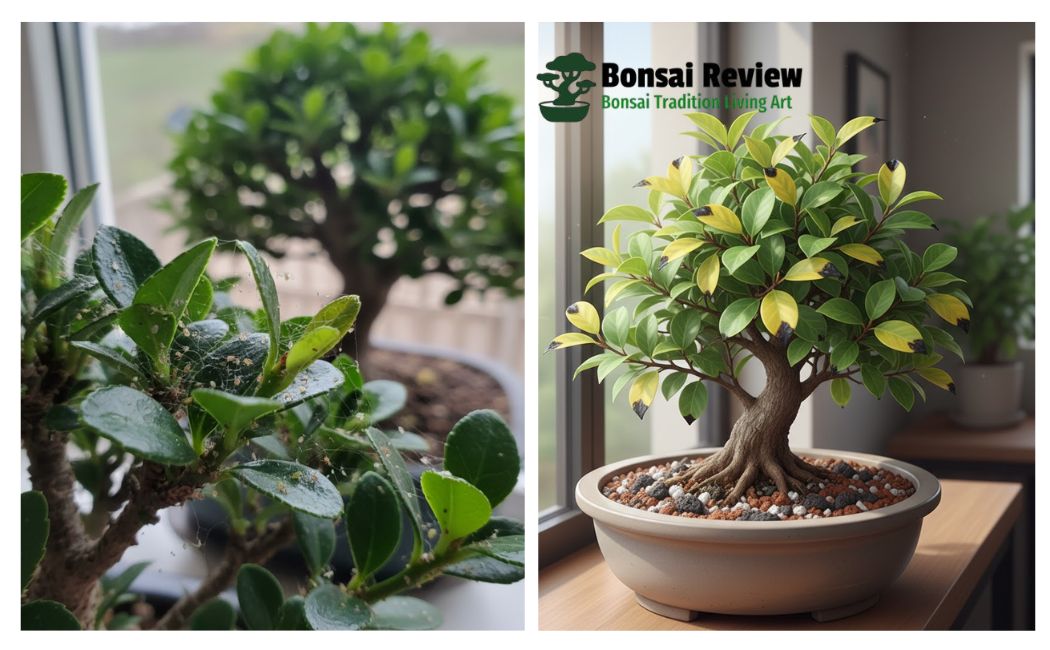
Problem 1: Overwatering and Root Rot in Los Angeles Bonsai.
One of the biggest Common Bonsai Problems and Solutions in Los Angeles growers make is overwatering. You might think your tree needs water every day because the air feels dry, but that’s what often causes root rot.
When bonsai soil stays wet for too long, air can’t reach the roots. The roots start to rot, and your bonsai leaves turn yellow or black at the tips. You might even smell a damp, sour odor from the pot; that’s your first warning sign.
This problem often happens with indoor bonsai trees or small species like ficus bonsai, lavender star bonsai, or juniper bonsai grown in compact pots. The fix is simple away always water only when the topsoil feels slightly dry.
Check with your finger or a moisture meter before watering again. Use a mix of akadama, pumice, and lava rock to keep the soil airy and free-draining.
Make sure your bonsai pot has drainage holes. No shortcuts here. In Los Angeles, overwatering becomes worse during cool nights and coastal fog.
So, water early in the morning and never let water sit at the base of your pot. By letting your bonsai breathe and keeping its roots dry but not dusty, you’ll stop root rot and help your little tree grow strong again.
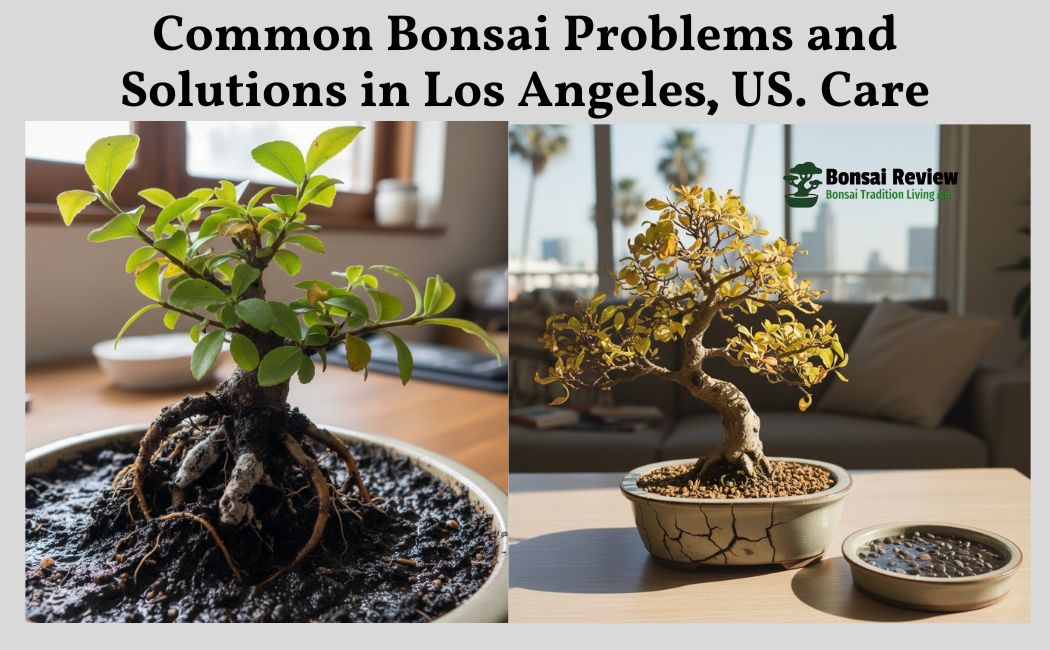
Problem 2: Underwatering and Dry Soil in Los Angeles Bonsai.
Bonsai Problems and Solutions in Los Angeles, US. If your bonsai leaves look crispy, dull, or start falling off, you’re likely facing underwatering, another common problem in the Los Angeles climate. The city’s dry air, hot afternoons, and especially the Santa Ana winds pull water from the soil faster than you expect.
Even when you water often, the shallow bonsai pot can dry out within hours. This hits trees like California juniper bonsai, olive bonsai, and lavender star bonsai the hardest.
When your bonsai soil gets too dry, the roots can’t pull in nutrients, and your bonsai plant becomes weak. The solution is to water deeply until water runs out of the drainage holes, then wait until the top layer feels dry again before watering next.
You can also add a humidity tray or mist the leaves in the morning to help your tree breathe better. For extra heat, move your bonsai into filtered light instead of full afternoon sun.
If you live inland, where the air is drier, your bonsai tree might need water even on mild days. Use a moisture meter to track soil dampness, and avoid letting the soil turn into dust.
With a steady watering habit and some light shade, your bonsai will stay hydrated, fresh, and full of life, even through LA’s toughest dry spells.
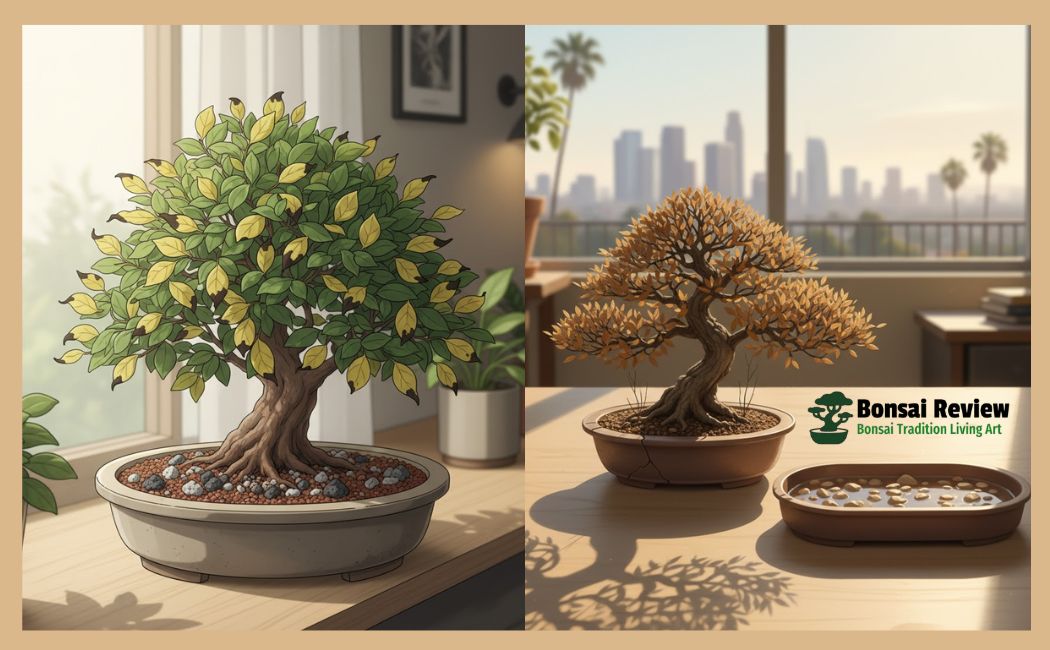
Problem 3: Leaf Burn and Sun Stress on Los Angeles Bonsai.
Your bonsai needs sunlight, but too much of it can hurt. In Los Angeles, the strong afternoon sun, especially during summer and the Santa Ana wind season, often causes leaf burn and sun stress.
You’ll notice brown or crispy edges, faded green color, or leaves that drop too early. This happens because the light intensity in Southern California is higher than what many indoor bonsai trees or tropical bonsai species can handle.
Ficus bonsai, jade bonsai, and lavender star bonsai are common victims when placed near windows that magnify heat. Even California juniper bonsai can get sunburned if exposed too long without gradual adjustment. The soil also bakes faster under direct sunlight, causing both heat stress and moisture loss.
To protect your bonsai, move it to a partly shaded spot with morning sun and afternoon shade. Use shade cloths or place them under a patio roof to soften harsh rays.
Mist your bonsai lightly during hot afternoons, but avoid wetting the leaves when the sun is directly overhead. A layer of mulch or moss on the soil can help retain moisture and keep roots cool.
Common Bonsai Problems and Solutions in Los Angeles US. Once you manage the sunlight balance, your bonsai will grow greener leaves and show new buds again, proof that even under the blazing LA sun, a little care goes a long way.
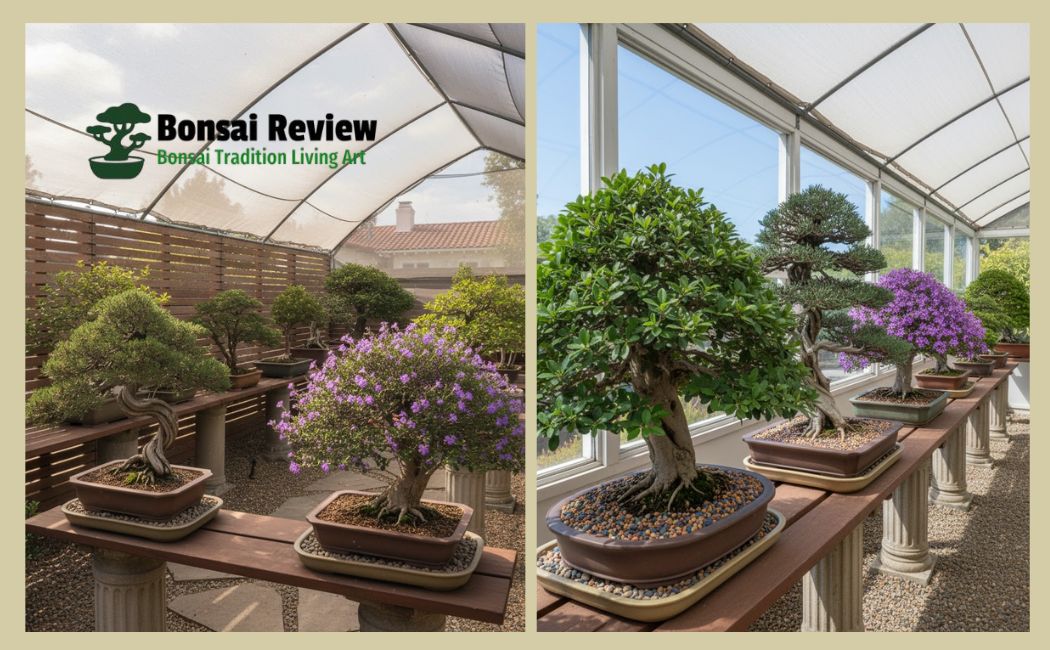
Problem 4: Pest Infestation on Los Angeles Bonsai.
Even when your bonsai soil, water, and sunlight are perfect, pests can still cause trouble. In Los Angeles, dry air and warm indoor or outdoor conditions make your bonsai plant an easy target for spider mites, aphids, scale insects, and whiteflies.
You might notice sticky leaves, small webs, or tiny insects crawling on the branches of your juniper bonsai, ficus bonsai, or lavender star bonsai.
The solution starts with regular inspection. Check the leaves and stems every few days. For mild infestations, gently wipe the leaves and spray a mixture of water and mild dish soap.
For persistent pests, use neem oil or a commercial insecticide safe for bonsai. Ensure good airflow around your trees to reduce humidity pockets where pests thrive.
In bonsai problems and solutions in Los Angeles, US, indoor bonsai trees are particularly vulnerable during winter when heating systems dry the air. By keeping an eye out and treating pests early, you can prevent damage to leaves and branches and keep your bonsai looking healthy all year round.
Problem 5: Leaf Yellowing and Black Tips.
Sometimes your bonsai shows yellow leaves or black tips even when you think you’re doing everything right. In Common Bonsai Problems and Solutions in Los Angeles, this is often caused by overwatering, underwatering, or nutrient imbalance in the bonsai soil. Hard tap water can also leave salt buildup, which stresses your ficus bonsai, California juniper bonsai, or lavender star bonsai.
To fix this, first check the soil moisture; water only when the topsoil is dry. Flush the soil occasionally with filtered or rainwater to remove salt deposits. Use a balanced bonsai fertilizer to provide essential nutrients. For indoor bonsai trees, ensure they get adequate sunlight near a south- or west-facing window, and rotate them regularly for even growth.
With these adjustments, your bonsai plant will recover its vibrant green color, healthy leaves, and strong growth. Understanding this simple cause-and-solution can save your bonsai from stress and keep it thriving in Southern California’s climate.
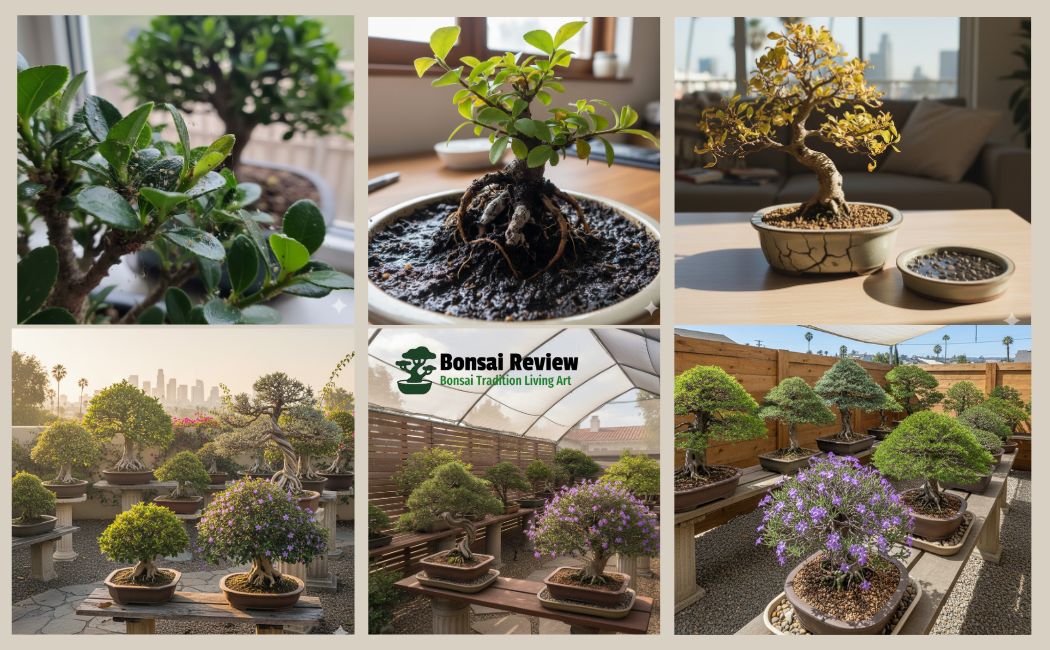
Common Bonsai Problems and Solutions in Los Angeles US: Specific Bonsai Care Tips.
Caring for bonsai in Los Angeles isn’t just about watering and pruning; it’s about adjusting to the Southern California climate. The city’s hot sun, dry air, and occasional Santa Ana winds affect how your bonsai plant grows, whether it’s a California juniper bonsai, lavender star bonsai, or ficus bonsai.
Here are common bonsai problems and solutions in Los Angeles, US, and how to protect your bonsai from local challenges:
- Sun and Heat: Place your bonsai in filtered light during the hottest hours. Shade cloths or light overhangs can prevent leaf scorch.
- Wind Protection: During Santa Ana winds, move outdoor bonsai to sheltered areas or provide temporary wind barriers to prevent rapid dehydration.
- Watering Adjustments: Check soil moisture daily. Even on mild days, inland bonsai may need extra water, while coastal bonsai can retain more moisture.
- Humidity Management: Use humidity trays or mist indoor bonsai to compensate for dry air caused by AC units.
- Soil and Fertilizer: Use well-draining soil (akadama, pumice, lava rock) and apply balanced fertilizer periodically.
- Local Resources: Visit Mid City Nursery, Southern California Bonsai Society, or Huntington Library Bonsai Collection for advice and supplies suited to LA’s microclimates.
By tailoring your routine to Los Angeles conditions, your bonsai tree can thrive all year, even under the city’s intense sun and wind. Small daily adjustments go a long way in keeping your bonsai healthy and beautiful.
Conclusion: Keep Your Bonsai Thriving in Los Angeles, US.
Caring for a bonsai in Los Angeles may seem tricky at first, but understanding the city’s Mediterranean climate, dry air, and Santa Ana winds makes it much easier.
By watching for common bonsai problems like overwatering, underwatering, leaf yellowing, black tips, pests, and sun stress and taking simple actions, you can keep your bonsai plant healthy and strong.
Bonsai Problems and Solutions in Los Angeles, US: Use well-draining bonsai soil, water only when the topsoil is dry, provide filtered light during hot afternoons, protect your trees from dry winds, and check for pests regularly.
You’re growing a Ficus bonsai, California juniper bonsai, or Lavender Star bonsai. These small steps tailored to Los Angeles conditions will help your bonsai flourish.
With consistent care and attention to local factors, your bonsai will reward you with vibrant green leaves, strong growth, and the peaceful presence that makes bonsai cultivation so special.
You don’t have to be an expert, just follow these routines, and your bonsai will thrive in LA’s sunny, dry, and sometimes windy environment.
Supported helpful article: Bonsai Tree Problems: How to Spot and Treat Pests and Diseases?
FAQs: Common Bonsai Problems and Solutions in Los Angeles, US.
1. How can grow indoor bonsai trees in Los Angeles apartments?
Yes! Indoor bonsai trees like Ficus bonsai or Jade bonsai do well indoors if placed near a south- or west-facing window. Use filtered light, maintain humidity with a humidity tray, and water only when the topsoil feels dry.
2. How often should I water my bonsai in Los Angeles?
It depends on your bonsai type and location. Indoor bonsai may need water every few days, while outdoor bonsai like California juniper bonsai may need more frequent watering during Santa Ana winds or hot afternoons. Always check the topsoil moisture before watering.
3. Which bonsai species are best for Los Angeles beginners?
Beginner-friendly species include Ficus bonsai, California juniper bonsai, Lavender Star bonsai, and Jade bonsai. They are tolerant of dry air, sun, and minor care mistakes.
4. How do I prevent pests on my bonsai?
Inspect your bonsai regularly for spider mites, aphids, scale, or whiteflies. Treat mild infestations with water and mild dish soap or use neem oil. Ensure good airflow and avoid overwatering to keep pests away.
5. Why are my bonsai leaves turning yellow or black-tipped?
Yellow leaves or black tips are often caused by overwatering, underwatering, poor soil drainage, or salt buildup from hard tap water. Use well-draining bonsai soil, water only when the topsoil is dry, and flush the soil with filtered water occasionally.
6. How do I protect my bonsai from the Los Angeles sun and heat?
Place your bonsai in filtered sunlight, avoid direct afternoon sun, and use shade cloths if necessary. For outdoor bonsai, move them to a sheltered area during Santa Ana winds to prevent leaf scorch and dehydration.
7. Are there local resources for bonsai care in Los Angeles?
Yes! Common Bonsai Problems and Solutions in Los Angeles, US, with expert support in physical store and their online resource. Visit Mid City Nursery, Southern California Bonsai Society, Huntington Library Bonsai Collection, or local bonsai clubs for advice, forums, workshops, and LA-specific care tips.